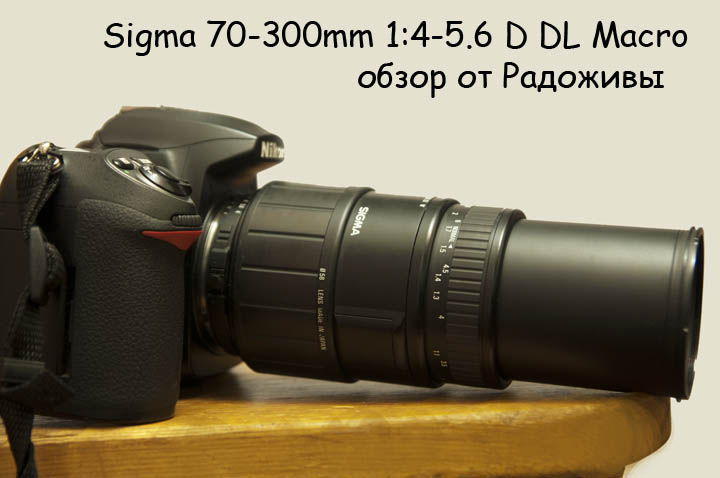
View Sigma AF 70-300mm F4.0-5.6 D DL MACRO
This review shows the Sigma 70-300mm F4.0-5.6 D DL MACRO - DL Macro 14/11 version with 1 SLD element.
Characteristic features of the Sigma 70-300mm F4.0-5.6 D DL MACRO, by which you can determine the version:
- large convex switch 'NORMAL || MACRO at 300 '
- macro mode only works at 300 mm focal length
- the prefix D DL MACRO in the name
- thin focus ring (diameter smaller than zoom) marker 'NORMAL' near 1.7 meters
- scale with magnification only for values 1: 3.5, 1: 3, 1: 2.5, 1: 2
History
There are a huge variety of various modifications, versions and subversions of Sigma class 70 (75) -300 mm lenses (approximately 13 versions).
The reasons for this wide variety are:
- Continuous lens improvement. For example, older versions designed for film cameras have been updated for better compatibility with digital cameras. Marking versions optimized for digital cameras includes the prefix 'DG'(latest versions from this line - DG, Apo dg, OS DG) First of all, the updates concerned enlightenment.
- Improvement of lenses by increasing the number of low dispersion elements Sigma SLD (Special Low Dispersion). Sigma lenses with 14/11 and 14/10 optical designs may have different numbers of SLD elements. An increased number of SLDs can be recognized using the prefix APO (apochromat) and red decorative ring. The APO 14/11 version has 1 SLD element more than the NON-APO version. The APO 14/10 versions have 2 SLD elements more than the same NON-APO versions.
- Non-observance of unitary marking for lenses with different mounts. So, for example, for Nikon cameras, some 70-300 Sigma lenses in their name written on the housing may include the additional letter 'D'(indicates the possibility of transferring the focusing distance to the camera). Also, the same version / sub-version for cameras of different systems can have a different style of its name on the body (for example, different parts of the name can be written in golden letters). Over time, the same version / subversion could change the location and method of applying name markers on your case.
- Most likely the versions of Macro Super, Macro Super II, unlike earlier models, have the ability to macro in the range of 200-300 mm. Earlier models had this mode only at 300 mm focal length.
- Improvement of lenses with body design changes... There are so-called 'second' lens sub-versions, for example DL Macro Super -> DL Macro Super II, APO Macro Super -> APO Macro Super II. Identification is complicated by the fact that there is no 'II' indication on the case, the 'II' mark is found only on the box and / or instructions. Such subversions can be distinguished the width of the focus ring, newer versions have a focus ring that is smaller in diameter than a zoom ring. There are also versions with a velvet-coated housing.
- In 2008, the DG and DG APO for Nikon cameras are updated to sub-versions with a built-in focus motor. New versions with a built-in focus motor do not have an aperture control ring, and number of microprocessor contacts increased to 10. All previous Sigma / Quantaray lenses for Nikon cameras came with no built-in focus motor.
- These lenses were also branded Quantaray. Finding out which version of the Sigma 70 (75) -300 is hiding under the name 'Quantaray' can be more difficult than with the original Sigma lenses.
In the general case, four main classes can be distinguished (depending on the optical design):
- Optical design 14/11, used in the first versions. APO subversion used 2 SLD elements. Conventional subversions used 1 SLD element. It is easy to distinguish by the very 'chubby' switch 'NORMAL MACRO 300' (only 300).
- Optical design 14/10, used in a huge variety of subversions. APO subversion used 3 SLD elements. Conventional subversions used 1 SLD element. Easy to distinguish by the small / conventional 'NORMAL MACRO (200-300)' switch (in the range of 200-300). Curious that the lens Olympus Zuiko Digital ED 70-300mm 1: 4-5.6 ED Replicates the Sigma 14/10 optical circuit with 3 SLD elements.
- Optical design 16/11, used only in the latest version with image stabilizer.
- Lenses with a 14/11 optical design are easily recognizable by the focal length range of 75-300 mm.
List of major versions:
- APO Macro 14/11 (2 SLDs)
- DL 14/11 (1 SLD)
- DL Macro 14/11 (1 SLD)
- DL Macro Super 14/10 (1 SLD)
- APO Macro Super 14/10 (3 SLD)
- DL Macro Super II 14/10 (1 SLD)
- APO Macro Super II 14/10 (3 SLD)
- DG Macro 14/10 (1 SLD) (for Nikon, there are 2 options depending on the focus motor and aperture ring)
- DG APO Macro 14/10 (3 SLD) (for Nikon, there are 2 options depending on the focus motor and aperture ring)
- DG OS 16/11 (1 SLD)
- 14/11 with a focal length of 75-300
The information I provided may not be accurate or incomplete, please, experienced users, please indicate inaccuracies in the comments.
All my reviews of such lenses (marking according to the inscriptions on the case):
- Sigma 70-300mm 1: 4-5.6 (for Canon, Macro 200-300)
- Sigma 70-300mm 1: 4-5.6 D D.L. Macro (for Nikon, Macro AT 300)
- Sigma 70-300mm 1: 4-5.6 D DL MACRO SUPER (for Nikon, Macro 200-300)
- Sigma 70-300mm D 1: 4-5.6 Apo dg (for Nikon, Macro 200-300)
- Sigma 70-300mm 1:4-5.6 DG OS (for Canon)
- Quantaray 70-300mm 1: 4-5.6 D LDO Macro (for Nikon, Macro AT 300)
- Quantaray 70-300mm 1: 4-5.6 D LDO Macro (for Nikon, Macro 200-300)
- Sigma Zoom AF-APO 1:4.5-5.6 f =75-300mm multi-coated Macro (for Nikon)
- Quantaray TECH-10 NF AF MULTI-COATED 1: 4-5.6 f =75-300mm (for Nikon)
A catalog of modern Sigma telephoto lenses is available see here.
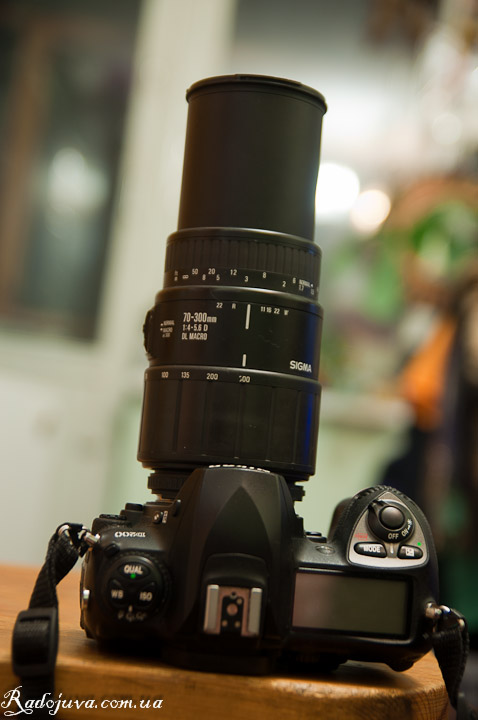
Sigma AF 70-300mm F4.0-5.6 DL MACRO
The first impression of the lens is that it is not heavy at all. When used, you immediately feel that the zoom ring is quite large, rubberized with very rough rubber. When zooming, the trunk extends as in most 70-300 zooms.
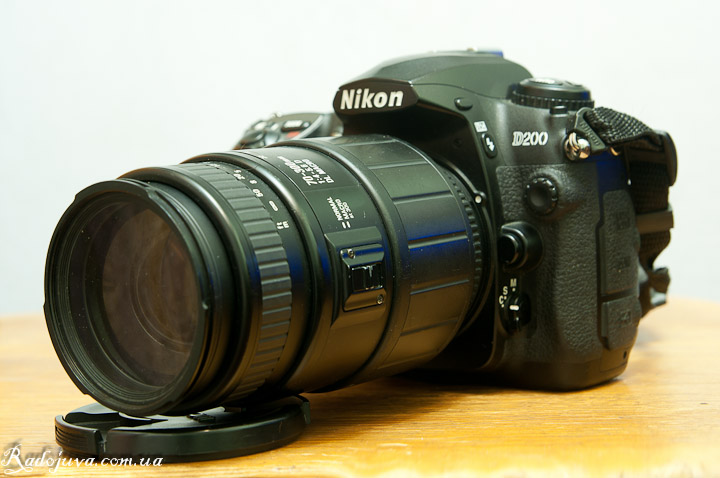
View Sigma AF 70-300mm F4.0-5.6 DL MACRO at 70mm
Important points about the Sigma 70-300mm 1: 4-5.6 D DL Macro lens (both good and bad):
- The lens is also suitable for full-frame cameras and for cameras with APS-C cameras. That is, the lens will work on Nikon D3 and Nikon D50.
- When used on cameras with an APS-C sensor (on a cropped matrix), the angle of the field of view will be narrower and equal to the focal length lens 105-450mmThat is a real body range. If it’s not clear, read the article about crop factor.
- The lens has aperture control ring, which means it can also be used on film cameras, and also, this is a very useful feature for various kinds of photo experiments, for example, for shooting macro in the reverse position of the lens. In order for Nikon cameras to be controlled from the camera, you need to set the minimum aperture F22 on the lens. If this is not done, the camera will not recognize the lens and will write fEE in the aperture value field. To lock the position of the diaphragm and use the automatic iris control, a special lock button on the lens is used. When set to F22, it can lock the aperture ring in that position. This is exactly how the aperture ring is arranged, for example, on a native Nikon lens Nikon 50mm F1.8D.

Sample photo on Sigma AF 70-300mm F4.0-5.6 D DL MACRO
- The lens has macro opportunity... This is the only option available with a focal length of 300mm and 'Macro at 300' mode enabled. When switched to 'Macro at 300' mode, the focus ring can rotate a few more degrees, lengthening the trunk and achieving 1: 2 macro. Of course, 1 to 2 isn't a real macro, but it's a very useful feature nonetheless. Also, keep in mind that zooming is blocked in this position. When the 'Macro at 300' mode is on, you will not be able to zoom until you switch the lens to the “Normal” mode. Most interestingly, autofocus works in both modes. The camera can focus itself in the “Macro at 300” mode. For example, a lens Nikon 35-70mm f / 2.8 AF-D ZOOM-NIKKOR cannot automatically focus in macro mode.

Example macro photo on a Sigma AF D 70-300mm F4.0-5.6 DL MACRO shot with hands in macro mode
- The lens contains all the necessary indicators - aperture, focal length, focusing distance, depth of field (for F11, 16, 22), as well as the magnification factor in the 'Macro at 300' mode.
- The diameter of the front lens under the filter 58mm.
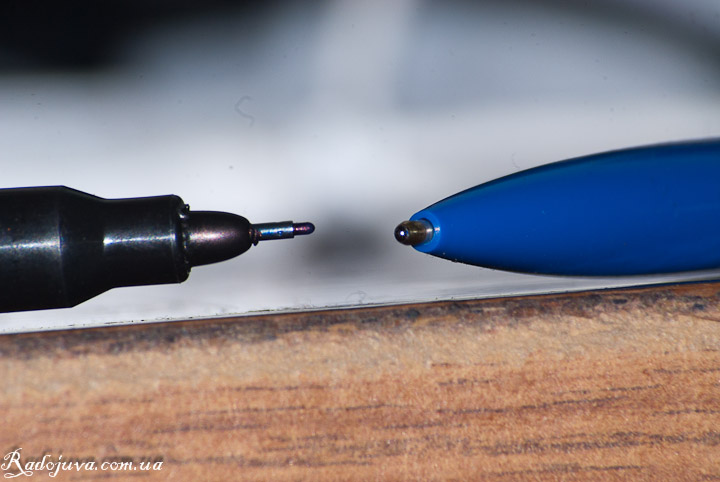
Macro on Sigma AF 70-300mm F4.0-5.6 DL MACRO
- When focusing, the front of the lens (trunk) and moves back and forth and turns. This makes it quite difficult to use special photo filters (gradient and polarization). Brother Nikon 70-300mm f 4.5-5.6G IF-ED AF-S VR Zoom-Nikkor does not have such an ailment.
- When zooming, the back of the lens moves, drawing in air. This is normal for this class of lens. But still, air therefore contributes to the absorption of dust into the chamber.
- There is no focus mode switching ring on the lens, it is not always convenient when using.

Photograph on Sigma AF 70-300mm F4.0-5.6 DL MACRO
It's important: auto focus with this lens is available only when using him on cameras with built-in motor focusing.
Exact list Nikon DSLR cameras with a built-in focus motor, on which this lens will focus automatically:
- D1, D1h, D1x, D2x, D2xs, D2h, D2hs
- D3, D3x, D3s, D4, D4s, D5, D6
- Df
- D50, D70, D70s, D80, D90
- D7000, D7100, D7200,D7500
- D100, D200, D300, D300s,D500
- D600, D610, D750, D780
- D700, D800,D800E, D810, D810a, D850
- Fujifilm FinePix S1 Pro, S2 Pro, S3 ProS3 Pro UVIR, S5 ProIS Pro
- Kodak DCS PRO 14n, DCS Pro SLR/n
Exact list Nikon DSLR cameras without a built-in focus motor, on which this lens will not focus automatically:
Only auto focus and sound confirmation of focus will not work with these cameras, all other important functions, such as automatic exposure metering and automatic iris control, will work well.
You will find a lot of useful information on the types of cameras and lenses Nikon here.
About the picture: The lens gives a sharp picture up to 200mm. Excellent sharpness is achieved at an aperture of 8.0 - for a budget telephoto, this is quite normal. From 200 to 300mm you have to work very hard to get a sharp image. Surprised that HA even at 300mm, even in very contrasting areas of the image within normal limits. Vignetting is even present on the crop, you can carefully look at the photo with a flying airplane yourself. The contrast is not very good, the color rendering is excellent. Distortion is almost invisible, but still takes place. The lens is great for photographing portraits, a large focal length allows you to well control the depth of field, which depends inversely on the square of the focal length, so do not pay attention to the fact that aperture the lens is small.
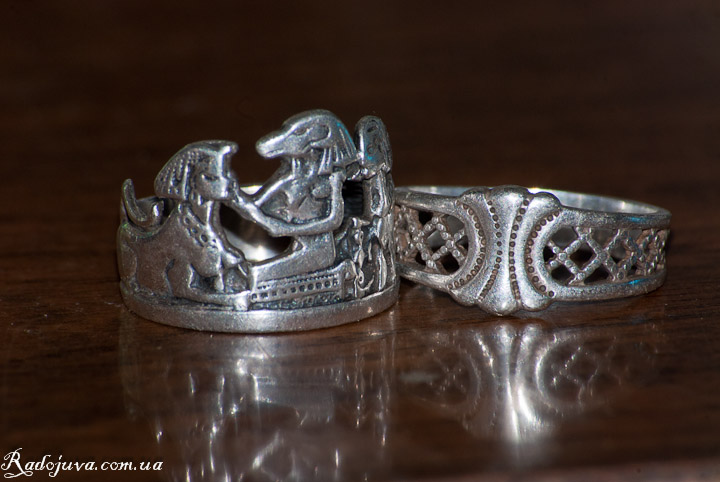
Example macro photo on a Sigma AF 70-300mm F4.0-5.6 DL MACRO
Personal impressions: autofocus at the lens is slow, this is due to focusing with a screwdriver and the fact that in macro mode the angle of the focus ring increases significantly and the camera needs to turn the lens focuser for a very long time. This is not pleasant enough when in macro mode the focuser goes there for about a few seconds. With the trunk extended, the lens has a rather funny look. In general, the lens did not produce РІРІРμС ‡ Р ° С,Р »РμРЅРёС Р. My native Nikon 70-300mm f / 4.5-5.6G IF-ED AF-S VR Zoom-Nikkor better in a row of indicators except macro. You always need to remember important how to take pictures, and not on which technique, and then the photos will be great.

Sample photo on Sigma AF D 70-300mm F4.0-5.6 DL MACRO
If you still really want to use the lens on non-motorized cameras like Nikon D40, Nikon D3000, then all other functions will work in the same way as on autofocus lenses, and the green dot in the lower left needle of the optical viewfinder will indicate the accuracy of focusing. Well, if you have a camera like Nikon D5000, Nikon D3100, Nikon D5100, then you can focus on sharpness in Live View.

Sample photo on Sigma AF D 70-300mm F4.0-5.6 DL MACRO
Sample photos on Sigma 70-300mm 1: 4-5.6 D DL Macro (without processing, the picture is like the ADC gave birth to it Nikon D200, RAW -> JPEG, resized 1600 * 1200, watermark).
On sale Sigma 70-300mm F4.0-5.6 D DL MACRO new not found. To use it is preferable to look at a newer model Sigma APO DG 70-300mm 1: 4-5.6, prices for which you can see hereor in the price block located below:
All prices on Sigma APO DG 70-300mm 1: 4-5.6
All Original Similar Nikon FX Telephoto Lenses
Below is a list of all Nikon Nikkor telephoto lenses without high aperture and with auto focus support:
- Nikon AF Nikkor 70-210mm 1: 4, 1986-1987
- Nikon AF Nikkor 70-210mm 1:4-5.6, 1987-1993
- Nikon AF Nikkor 75-300mm 1:4.5-5.6, 1989-1998
- Nikon AF Nikkor 80-200mm 1:4.5-5.6D, 1991-1999
- Nikon AF Nikkor 70-210mm 1:4-5.6D, 1993-2000
- Nikon AF Micro Nikkor 70-180mm 1: 4.5-5.6D ED, 1997-2005
- Nikon AF Nikkor 75-240mm 1:4.5-5.6D, 1999-2000
- Nikon AF Nikkor 70-300mm 1:4-5.6D ED, 1998-2006
- Nikon AF Nikkor 70-300mm 1:4-5.6D, 1998-2006 (?)
- Nikon AF Nikkor 70-300mm 1:4-5.6G, from 2000 to 2014, black or silver
- Nikon AF S Nikkor 70-300mm 1:4.5-5.6G ED VR IF SWM, from 2006 to 2017
- Nikon AF S Nikkor 70-200mm 1: 4G ED SWM VR IF N Nano Crystal Coat, from 2012 to the present day
- Nikon AF-P Nikkor 70-300mm 1:4.5-5.6E VR ED, 2017 to present
The names of the lenses are indicated according to their spelling on the case.
The catalog of modern Sigma telephoto lenses can be viewed here.
Comments on this post do not require registration. Anyone can leave a comment. Many different photographic equipment can be found on AliExpress.
Conclusions:
Sigma turned out to be pretty compact and nice lens. True, autofocus will work only on cameras with a built-in motor, and you need to close the diaphragm at the long end to get a sharp enough image. Very pleased with the macro at 300mm, however, to visit the sharpness in macro mode at 300mm is quite difficult.
Material prepared Arkady Shapoval. Training/Consultations | Youtube | Facebook | Instagram | Twitter | Telegram

















But no, I messed up everything. I just have a Sigma 70-300mm F4.0-5.6 DG MACRO, no AF. I can't learn all these abbreviations. In general, apparently, this is the very "ghost" Sigma with a motor. The inscription on the box says Built-in Motor Drive.
But can it be through an adapter to kanan 1100d? thanks
Hi Arkady! An interesting thing is I click on the Sigma AF 30mm f / 1.4 EX DC HSM for Nikon review, and get on the Vivitar Series 1 90mm 1: 2.5 VMC Macro Review :)))!
Yak to your thought є sensor to buy Nikkor AF 70-300mm f / 4-5.6G and yak sho I can list plus camera Nikon D80 in staff 50 mm. 18d Pentaks 135 2.8 I want autofocus telephony
Hello, Arkady.
How do you see Sigma having less variation in quality than Tamron? She is more expensive than him.
Advise !!! I love shooting super macro ... which lens should I choose for the Nikon D7000?
which is better for Nikon D3100 Nikon DX AF-S NIKKOR 55-300mm or this Sigma 70-300mm?
or maybe Tamron AF 70-300mm F / 4-5.6 Di LD MACRO 1: 2 Nikon F
please tell me which of 3 to take
What is the best lens for CANON 1100D
sigma af apo 70-300mm f / 4-5.6 macro dg OR tamron af apo 70-300mm f / 4-5.6 macro di ld?
It’s just that sigma has less HA, but tamron has colors that are smooth and bright, but there are HA
Please tell me, I will be very grateful!)
Arkady, at first he did not impress you, but then turned out to be a nice lens! And still? And they didn’t say anything about stabilization!
There is no stabilizer in it.
Hello Arkady! Will this lens fit Sony Alpha 65?
Arkady, thanks for the interesting and unbiased reviews! If possible, please make one for the Sigma AF 100-300mm f / 4 EX DG HSM APO. Glass, however, is no longer available, it is only on the secondary market (I purchased it, for example, from a photographer from another country), but the quality, in my opinion, is very, very worthy and deserves the attention of not only amateurs, but also professionals
> Personally, I think this is a complete analogue of the Sigma AF 70-300mm F4.0-5.6 DG MACRO
These are exactly different models, with a difference of several generations. Different optical formulas, different numbers of aperture blades, and finally, in the newer model, the macro mode works not only at 300 mm, but in the range from 200 to 300. These are only the most noticeable differences. Plus, the new model has DG enlightenment for the rear element.
Fixed
Sigma for Canon only works on an open aperture. Maybe someone knows if the aperture will work if Sigma 70-300 for Nikon is screwed onto the Canon 60d through an adapter?
Thanks in advance)
Arkady tell me pliz on KENON 550D I can use it, I want to buy it, and how it will work, I correctly understood that autofocusing will not work and will it need to be focused manually?
Hello. Advise how to restore contacts on the focus mode switch for sigma 70-300 dg macro.
Thanks for your work, the reviews are good. True, I did not find what I needed. Interested in Sigma AF 70-200mm f / 2.8 APO EX DG OS HSM Nikon F
or something better, but so far have not been able to find friends for the test.
And the skilky megapixel Sigma 70-300mm 1: 4-5.6 D DL Macro
Hello. In your opinion, what will be better?
Tamron AF70-300mm F / 4-5.6 Di LD Macro 1: 2
Sigma 70-300mm F4-5.6 APO DG MACRO
The Canon EF 75-300mm f / 4-5.6 III USM
Hello. Thanks for your reviews.
Please help me with a choice. We need a lens for shooting birds, wildlife. I choose between the Tamron AF70-300mm F / 4-5.6 Macro 1: 2, the Sigma 70-300mm F4-5.6 APO DG MACRO, and the Tamron AF80-210mm F4.5-5.6 178D. For canon 650d. I will very much wait for an answer.
Tell me, is it suitable for the Nikon d3100 or is it better to look for something else?
collided with a sigma 70-300 D, ME 5100 SAY THAT THIS LENS IS ONLY UNDER A SCREWDRIVER
They say absolutely for sure, I also have just such a lens - Sigma70-300mm D 1: 4-5,6 Macro. It does not have a built-in motor, therefore, unfortunately, only manual focusing is possible on the D5100. By this lens, I can see that in comparison with the similar Nikkor 70-300 G, it confidently wins over the latter in all respects, namely: much sharper at the long end of the FR, chromatism and freezing are also much less pronounced, macro mode in Nikkor just no, the Sigma's aperture is higher, the focusing is not fast, but accurate enough - there are simply no misses on the D200 and D300s, even in the dark. The only "weak" point is the zoom lens design, but maybe after 12 years of use, a tight stroke zoom rings - is this natural? In short, if this subject comes across to someone in a normal state - buy it, you will not regret it! At its ridiculous cost, the 70-300mm D Sigma is a great budget film telephoto lens with macro mode! (IMHO)
Igor in Sigma70-300 has a motor I have Sigma 70-300 DL- macro super Maybe I didn’t understand something What kind of money does it cost Please tell
https://ru.wikipedia.org/wiki/%D0%A1%D0%BF%D0%B8%D1%81%D0%BE%D0%BA_%D0%BE%D0%B1%D1%8A%D0%B5%D0%BA%D1%82%D0%B8%D0%B2%D0%BE%D0%B2_Sigma
This clumsily copied link will show a fairly large, but far from complete list of Sigma lenses. As for your lens, judging by the marking of the ultra-wave motor, it definitely does not have it (Sigma in the name of the UV motor means 'HSM'), but there are Sigmas that have no explicit indication of the motor in the name on the body except for a small sticker “Vis motor ”on the box. So when buying, it's better to check on a non-motorized carcass, and be sure to check back and front focus! Sigma suffers from this! Personally, for these purposes, I use an ordinary building tape measure, which I photograph at an angle - and misalignment and chromatism and frigging are immediately visible in one test. Among other things, the "budget" Sigma models have a "sore assembly curve", their lenses are "made in Japan ”, But the frames are plastic and the shanks are chrome-plated, obviously from the Middle Kingdom, trains, gears and contacts are from the same place. Therefore, buying a“ used ”Sigma at a high price is a very risky undertaking. Sigma 70-300 DL- macro super - if "non-motorized", then this is the 2nd "bottom" version (only my "D" version is easier), optically it is definitely not worse than Nikkorov 70-300 G and D versions (IMHO), her picture is rich and voluminous, but the mechanics leaves much to be desired. For what it can be sold - look at Foto.ua or on OLX. I think that on this site it is somewhat incorrect to name your prices for other people's things - out of respect for the Author , and so that not to offend colleagues. Personally, I will gladly share my opinion if you write to me at my address Igor-kb@i.ua.
All participants have good Old-New Year pictures, and most importantly - keep their equipment!
Many thanks. Thank you very much. Happy holiday.
Arkady a question for you! I’m searching for coins and other artifacts, I’m shooting it all on a SONY DSC-HX50 camera, the question is, after cleaning up the find, I want to take a close-up picture, but I can’t do it ..
Tell me, do I need another lens for this camera model, well, like “Sigma 70-300”, or will it not work?
And in general, maybe I do not need him? in the sense of a lens ..
Thanks in advance for the answer ..
These are the photos obtained, I want the object itself, so that I get more and more clearly ..
Your Sonya’s lens is not interchangeable, if you need to remove the largest ones from your Sonya, use the optical zoom and you’ll move the camera closer to the object, you couldn’t find the MDF, because it’s how close it is to experimentally verify.
If you need interchangeable optics, then you need to buy either mirrorless mirrors with interchangeable lenses of which there are many from different manufacturers now, or full-fledged SLRs.
Good evening,
Please help me sort out one problem.
I am the owner of this Sigma lens. The fact is that after I disassembled it cleaned and oiled, it lost its former sharpness. What could be the problem? Cleaned with alcohol wipes.
Let's go in a simple logical way: the lens was sharp, you 1-took it apart, 2-cleaned it, 3-blurred it, 4-assembled it. He stopped being sharp. The problem is one of your actions with the lens, in which the lens repairman will tell you exactly, for example.
Yuri,
The fact is that every step I took on the camera and put marks. Everything came together and sat down in its place.